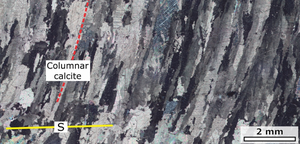Calcite pseudomorphs after aragonite: A tool to unravel the structural and exhumation history of marble-bearing high-pressure units - Paris Xypolias 09 maggio ore 12:00 aula Ruffini DST

Calcite pseudomorphs after aragonite have been reported in several marble-bearing HP/LT metamorphic units. The pseudomorphs form a columnar microstructure oriented normal to the foliation, which developed at peak metamorphic conditions within the stability field of aragonite. Modification of the columnar microstructure by bending of the long axis of the calcite pseudomorph and dynamic recrystallization, was mainly dependent on the intensity of subsequent, exhumation-related deformation. The degree of preservation or modification of the columnar microstructure observed in high-strain zones can be used to distinguish between the subduction- and exhumation-deformation. The degree of modification of the columnar microstructure can also be used as a tool to investigate variations in strain intensity, recrystallization mechanism and kinematics during the exhumation of the HP-marbles. In this seminar, it will be presented two natural examples from Evia and Syros Islands of the Cycladic massif (Greece), where calcite pseudomorphs after aragonite are used as deformation markers.
In Evia Island, the variation of calcite microstructures in the Basal unit was mapped. Microstructural data suggest that subduction-related ductile deformation preceded the growth of the columnar microstructure and was associated with internal imbrication by SE-directed thrusting. The ductile stage of the exhumation was characterized by strain localization at the middle and upper structural levels of the Basal Unit, and E-directed thrusting (i.e., northeast in pre-Neogene configuration). Final exhumation of the Basal Unit was achieved by top to-the-E ductile to brittle thrusting, which was accompanied by syn-orogenic extension at the upper crustal levels.
In Syros Island, two major HP/LT shear zones were studied, combining quartz and columnar calcite microstructures. These zones juxtapose meta-igneous rocks (hanging-wall) with calcite marbles (footwall) of the Blueschist unit. Quartz-rich bands within the hanging-wall of the shear zones record the deformation during the operation of the shear zones under HP conditions at slightly decreasing temperatures (from 500°C to 450°C) and are associated with (E)SE-directed shearing. Well-preserved columnar calcite within marbles of the footwall indicates that ductile shearing along the shear zones should have abruptly ceased during the early stages of exhumation, passing to a period of relative quiescence within the stability field of aragonite at temperatures ~430–450°C. Progressive exhumation and cooling below 400 °C are associated with weak and distributed (E)NE-directed shearing.
The speaker: Paris Xypolias (University of Patras)
Paris Xypolias is Full Professor of Structural Geology, and Head of the Department of Geology, University of Patras, Greece. His research interests focus on the analysis of ductile shear zones, the quantitative analysis of ductile deformation, the microtectonics, the exhumation mechanisms of HP/LT metamorphic units and the orogenic evolution of the Hellenides.
Onsite: h. 12:00 Aula Ruffini DST
Website at this link.
Contacts: geoseminar.dst@unito.it





